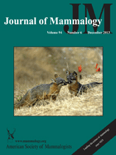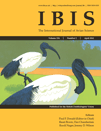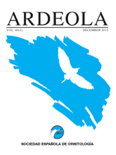
ORNIS FENNICA
Scope & Guideline
Bridging Theory and Practice in Ornithological Studies
Introduction
Aims and Scopes
- Ecology and Behavior of Birds:
The journal emphasizes studies that explore the ecological roles and behavioral patterns of birds, including foraging, migration, and territoriality. - Conservation Biology:
ORNIS FENNICA publishes research that addresses conservation issues, including population dynamics, habitat preferences, and the impact of human activities on bird species. - Avian Physiology and Reproductive Success:
Research on physiological adaptations, reproductive strategies, and survival rates of bird populations is a significant focus, providing insights into their life cycles and environmental responses. - Impact of Climate Change on Avian Populations:
The journal includes studies that examine how climate change affects bird migration patterns, breeding timings, and habitat distribution. - Human-Wildlife Interactions:
Research related to the interactions between birds and human activities, such as urbanization, agricultural practices, and wildlife management, is also a core area of interest.
Trending and Emerging
- Technological Applications in Avian Research:
The use of drones, GPS tracking, and automated counting methods is on the rise, showcasing a trend towards incorporating technology for enhanced data collection and analysis. - Climate Change Adaptation Strategies:
Research addressing how birds adapt to climate change, including shifts in migration patterns and breeding timings, is increasingly prevalent, reflecting global concerns about environmental changes. - Behavioral Ecology and Social Interactions:
There is a growing emphasis on understanding the social structures and behavioral adaptations of birds, particularly in relation to environmental pressures and resource availability. - Impact Assessments of Human Activities:
Studies assessing the impacts of urbanization, land-use changes, and agricultural practices on avian populations are becoming more common, highlighting the need for effective management strategies. - Conservation Genetics:
The integration of genetic tools in conservation studies to understand population dynamics and genetic diversity is emerging as a significant area of research in the journal.
Declining or Waning
- Artificial Nesting and Box Studies:
Research focused on the use of artificial nesting structures has decreased, possibly due to a shift towards studying natural habitats and behaviors in situ. - Traditional Birdwatching and Observation Studies:
Studies primarily based on observational data without robust analytical frameworks or experimental designs appear to be waning, as the field moves towards more quantitative and experimental approaches. - General Habitat Descriptions:
Papers that merely describe habitats without exploring specific ecological questions or management implications are less common, indicating a move towards more applied research. - Static Population Assessments:
There has been a reduction in studies that only assess bird populations at a single point in time, as the journal increasingly favors longitudinal studies that track changes over time.
Similar Journals

JOURNAL OF MAMMALOGY
Connecting Scholars for a Sustainable Future in MammalogyJournal of Mammalogy, published by Oxford University Press Inc, is a premier journal dedicated to the field of mammalogy, providing a key platform for researchers and professionals interested in the biology, ecology, and conservation of mammals. With a prestigious impact factor reflected in its Q1 ranking in Animal Science and Zoology, and multiple Q2 rankings in related categories such as Ecology and Genetics for 2023, this journal is recognized for its significant contribution to advancing knowledge in the discipline. The journal features rigorous peer-reviewed articles, ensuring high-quality research output valuable for students, academia, and conservation efforts alike. While not an open-access journal, it offers comprehensive subscription options for institutions and individual readers, promoting accessibility to critical findings in the realm of mammal research. Established in the earlier years of the 20th century, the Journal of Mammalogy has continuously evolved, serving as an integral resource for disseminating innovative studies and insights that drive the future of mammalian sciences.

MAMMAL STUDY
Advancing knowledge in mammalian biology and conservation.Mammal Study, published by the Mammalogical Society of Japan, is a leading academic journal dedicated to the field of mammalogy and related biological sciences. Since its inception, it has provided a critical platform for researchers, professionals, and students to share their findings and insights into the diverse facets of mammalian biology, ecology, and conservation. The journal, with ISSN 1343-4152 and E-ISSN 1348-6160, is recognized for its rigorous peer-review process and has attained a commendable Q3 ranking in the 2023 category of Animal Science and Zoology. With an impact factor reflecting its growing influence—ranking 283 out of 490 in Scopus—we welcome contributions that advance the understanding of mammalian species and their habitats. While access to published articles is through traditional channels, the journal aims to reach an even wider audience by fostering greater awareness and appreciation for mammalian research and conservation efforts. The Mammal Study has converged years of insightful publications from 2008 to 2024, solidifying its position as a vital resource in the biological sciences.

IBIS
Innovating insights in animal science and conservation.IBIS, published by WILEY, stands as a prestigious journal in the field of animal science, zoology, and ecology since its inception in 1859. With a focus on innovative research that informs the scientific community on ecological dynamics, behavioral studies, and conservation strategies, IBIS fills a critical niche for researchers, professionals, and students alike. The journal is recognized for its robust impact factor and commands a Q1 ranking in three key categories as of 2023, demonstrating its influence and reach within the global academic landscape, particularly in Animal Science, Ecology, Evolution, Behavior and Systematics, and Nature and Landscape Conservation. Although not an open-access publication, its rigorous peer-review process ensures high-quality contributions that advance knowledge in these vital areas. Through interdisciplinary collaboration and comprehensive coverage of cutting-edge topics, IBIS remains an essential resource for those striving to understand and protect our natural world.

Avian Biology Research
Empowering the next generation of avian researchers.Avian Biology Research, published by SAGE PUBLICATIONS LTD, is a leading journal dedicated to advancing the study of avian species through high-quality, peer-reviewed research. With an ISSN of 1758-1559 and an E-ISSN of 1758-1567, this journal has established itself as a vital resource within the fields of Animal Science and Zoology, as well as Ecology, Evolution, Behavior, and Systematics. The journal is currently ranked Q3 in both categories according to the 2023 release of the category quartiles, and it contributes significantly to the global understanding of avian biology, including behavior, physiology, and conservation efforts. Positioned within the competitive landscape of the Scopus rankings, it finds itself amidst a diverse array of research, with medical and environmental implications. As an open-access journal, Avian Biology Research ensures greater accessibility to its contents, fostering disseminative opportunities for researchers, professionals, and students alike. With a publication window spanning from 2008 to 2024, it continues to be an invaluable platform for the dissemination and dialogue of avian research, thereby enlightening future inquiries and driving scientific advancements in this crucial area of biology.

European Zoological Journal
Elevating the Study of Animal Sciences Across EuropeEuropean Zoological Journal, published by Taylor & Francis Ltd, is an esteemed open-access publication dedicated to advancing the exciting field of zoology. Since its inception in 2017, this journal has progressively established itself as a vital resource for researchers, professionals, and students alike. With its Q2 ranking in Animal Science and Zoology as of 2023, the journal ranks in the 69th percentile among its peers, showcasing its influence and contribution to the discipline. The journal’s broad scope covers a wide range of topics within zoology, aiming to foster an understanding of animal biology and conservation efforts. As an open-access journal, it not only enhances the dissemination of knowledge but also encourages collaborative research across global communities. Situated in the United Kingdom, the European Zoological Journal invites submissions that contribute to the evolving discourse in animal sciences, and endeavors to support the scientific community in addressing pressing ecological challenges.

WATERBIRDS
Exploring the Depths of Avian ScienceWATERBIRDS, published by the WATERBIRD SOC, serves as a vital scholarly resource in the field of Animal Science and Zoology. With its ISSN 1524-4695 and E-ISSN 1938-5390, this journal has established a significant presence since its inception in 1996, continuing to contribute valuable insights and research up to 2024. Recognized for its impact within the academic community, WATERBIRDS is currently positioned in the third quartile (Q3) for its category in 2023, ranking 335 out of 490 in Scopus's Agricultural and Biological Sciences sector, which underscores its role in promoting the study of avian species and their habitats. The journal is accessible to a wider audience, aligning with the growing demand for open access to scientific knowledge. By disseminating research that addresses both ecological and conservation issues pertinent to waterbirds, this publication serves as an essential platform for researchers, professionals, and students dedicated to advancing the understanding of avian biology and related fields.

Ardeola-International Journal of Ornithology
Illuminating the World of BirdsArdeola - International Journal of Ornithology, published by the SOCIEDAD ESPAÑOLA DE ORNITOLOGÍA, serves as a vital platform for the dissemination of research in the field of avian studies. With a history dating back to 1980, this esteemed journal has cultivated a reputation for high-quality research, achieving a notable Q2 category ranking in Animal Science and Zoology as well as in Ecology, Evolution, Behavior, and Systematics as of 2023. While primarily based in Spain, Ardeola caters to a global audience, providing essential insights into ornithology through rigorously peer-reviewed articles. The journal does not currently operate under an open-access model, which underscores the significance of institutional subscriptions and the importance of supporting academic publishing. Researchers, professionals, and students engaged in avian ecology will find Ardeola indispensable for accessing impactful studies that advance our understanding of bird populations, behaviors, and conservation issues. With its accessibility and continuing commitment to excellence, Ardeola plays a crucial role in fostering knowledge and promoting dialogue in the ornithological community.

Avian Conservation and Ecology
Championing open access for avian knowledge and action.Avian Conservation and Ecology, published by the Resilience Alliance, is a premier open-access journal dedicated to advancing the scientific understanding and management of avian populations and their ecosystems. With an ISSN of 1712-6568, this journal has been a vital resource since its inception in 2005, ensuring that research findings are readily accessible to the global community. Based in Canada, it covers a diverse array of topics within the realms of Animal Science, Zoology, Ecology, and Conservation. Recognized for its rigor, it boasts a distinguished Q1 ranking in Animal Science and Zoology, and maintains respectable positions in various ecological categories as of 2023. Researchers and students alike will find valuable insights and innovative studies that address key conservation challenges, reflecting the journal's commitment to fostering ecological resilience and informing policy-making. As a platform that champions open access, Avian Conservation and Ecology plays a crucial role in enhancing collaboration and communication among scientists, policy-makers, and the public。

ORNITOLOGIA NEOTROPICAL
Fostering collaboration in the study of avian diversity.ORNITOLOGIA NEOTROPICAL is a vital journal dedicated to advancing the field of Neotropical ornithology, published by the esteemed Neotropical Ornithological Society in collaboration with the USGS Patuxent Wildlife Research Center. With an ISSN of 1075-4377, this journal serves as a platform for researchers, professionals, and students to disseminate important findings related to avian biodiversity, ecology, and conservation in the Neotropical region. Although currently classified in Q4 quartiles for both Animal Science and Zoology and Ecology, Evolution, Behavior and Systematics, ORNITOLOGIA NEOTROPICAL has been gaining recognition since its inception in 2005. The journal promotes open discussions and rigorous methodologies that significantly contribute to the understanding and protection of avian species. By facilitating accessibility to cutting-edge research and fostering a collaborative scientific community, ORNITOLOGIA NEOTROPICAL aims to enhance the impact and importance of ornithological studies in the Neotropical domain.

BMC Zoology
Fostering collaboration in zoological research.BMC Zoology, published by BMC, is a distinguished open-access journal that has been advancing the field of zoological research since its inception in 2016. With an impressive Q2 ranking in both Animal Science and Zoology categories as of 2023, the journal occupies a significant position in the academic landscape, engaging a global readership dedicated to the exploration of animal biology. Based in the United Kingdom, BMC Zoology prides itself on providing a platform for innovative research, fostering collaboration among scientists, and facilitating access to high-quality scholarly articles. Researchers and practitioners in zoology can benefit from its extensive repository of articles that span various areas including conservation, ecology, and evolutionary biology. As an essential resource for scholars and students alike, BMC Zoology commits to enhancing the dissemination of knowledge in the zoological sciences through its open-access model, ensuring widespread access to cutting-edge research findings.